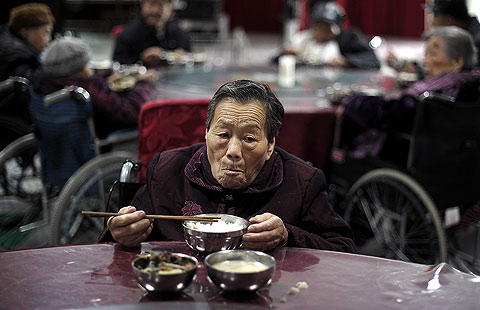Cruise lines push throttle on China expansion plans
Updated: 2014-04-18 07:21
By Gao Changxin and Shi Jing in Shanghai (China Daily USA)
|
|||||||||
Royal Caribbean International announced on Thursday that it will permanently reposition its most luxurious and hottest cruise ship to China, a move that underscores the country's growing importance in the world's cruise market.
The 4,180-passenger Quantum of the Seas, Royal Caribbean's newest ship, will move its home port to Shanghai in May 2015, the Miami, United States-based company said at a news conference in Shanghai. The ship will sail three- to eight-night voyages year-round from Shanghai to Japan and South Korea, following its maiden season, which will launch in November from the US to the Bahamas and the Caribbean.
"People in China have grown to expect the best the world has to offer, and Quantum of the Seas meets that standard like no other ship," said Adam Goldstein, president and COO of Royal Caribbean Cruises Ltd.
"We are ready to accelerate the growth of this vital market with a ship that will capture the imagination of travelers looking for a one-of-a-kind vacation experience."
Currently being built in Germany, the new cruise liner will offer sky diving and an indoor sports and entertainment complex that will feature bumper cars and roller-skating. A total of 18 restaurants will be onboard, including one created in partnership with British celebrity chef Jamie Oliver.
Quantum of the Seas joins Royal Caribbean's two existing ships that are dedicated at least part of the year to the Chinese market: the 3,114-passenger Mariner of the Seas and 3,114-passenger Voyager of the Seas. The new ship will boost the company's capacity in the region by 66 percent.
Royal Caribbean is just one of a flotilla of cruise operators seeking to enlarge their presence in China.
Carnival Cruise Lines opened up five new offices in China and has forecast that Asia's share of the global cruise market will double to 20 percent by 2020, with China being a major growth engine. A report jointly published by the World Travel Market and Euromonitor International last November reported that China is on track to become the second-largest global cruise market by 2017, after the US.
According to the 2013 Cruise Tourism Market Research report published by Baidu Inc's travel website Qunar.com, more than half of respondents said they would spend 4,000 to 6,000 yuan on a cruise. Shanghai is the city with the most people booking cruises in China, followed by Beijing, Hangzhou, Tianjin, Suzhou and Wuxi.
Gao Xing, product director for Qunar, said that although they started late in China, safe and secure cruises have become quite popular, and are mostly preferred by parents with children and retired couples.
According to Royal Caribbean's Goldstein, "Every trend we are seeing in China tells us we can achieve real long-term competitive advantage and appealing returns on our investments in this fast-growing market by accelerating our presence there."
Contact the writer at gaochangxin@chinadaily.com.cn and shijing@chinadaily.com.cn
Smaller liners gaining popularity in nation
Luxury cruises on small and medium-sized liners are becoming rapidly more popular with Chinese customers, according to a survey from HHtravel, the high-end brand of China's largest online travel agency Ctrip.com International Ltd.
Larger cruise ships mainly travel to Japan, South Korea and Southeast Asian nations, targeting middle and lower-end clients. High-end cruises mainly focus on tourist destinations such as the Baltic and Mediterranean, the polar region and Alaska, the survey showed.
"Once customers experience the smaller cruises, they will not go back to bigger ships," Ji Xiaojing, cruises product manager at HHtravel, said. "Ever since we introduced small cruises, they've generated up to 80 percent of our entire cruise sales with positive feedback."
Smaller cruises are superior to bigger ones in five main ways, Ji said: The ticket covers everything from on-board dining to onshore sightseeing, while there might be extra fees on bigger ships; a stateroom can be almost twice the size of those on larger vessels; there are fewer passengers, about 200 to 700; they can have Michelin-starred chefs; the ratio of passengers to service staff on a small cruise is about 1.5:1 and a 24-hour butler service is usually offered.
Trips sold by HHtravel last between 11 and 14 days and cost 70,000 yuan ($11,331) to 110,000 yuan. The most popular include Regent Seven Seas Cruises from Florida and Silver Sea Cruises from Italy.
Although smaller cruises have great scope for growth in China, they're a small slice of the Chinese market, particularly compared with Europe's.
"The world's top small and medium-sized cruises have hardly any products sold via Chinese travel agencies," Ji said. "Although there is much market demand, the industry has not followed up."
Industry statistics show the cruise industry grows in leaps and bounds when a country's per capita gross domestic product reaches $6,000 to $8,000. Last year in China, the figure stood at $6,920, signaling the industry's potential prime time for development.
(China Daily USA 04/18/2014 page17)

 Runners and their 4-legged friends race in New York
Runners and their 4-legged friends race in New York
 Top 10 Chinese Internet firms eyeing IPOs in US
Top 10 Chinese Internet firms eyeing IPOs in US
 Chinese cop cadets learn about US police work
Chinese cop cadets learn about US police work
 In Boston, warming up for, remembering marathon day
In Boston, warming up for, remembering marathon day
 Families of missing passengers face agonising wait
Families of missing passengers face agonising wait
 Couple leave the city for 'Self-sufficiency Lab'in mountains
Couple leave the city for 'Self-sufficiency Lab'in mountains
 Turning waste into something valuable
Turning waste into something valuable
 Dignitaries put their foot down
Dignitaries put their foot down
Most Viewed
Editor's Picks

|

|

|

|

|

|
Today's Top News
Scientists discover most earth-like planet
UN celebrates 2014 Chinese Language Day
4th US Navy official charged in bribery scheme
Nobel winner Marquez dies at 87
Chinese keen on Google Glass
Ferry's captain under probe
Texas seizes polygamist group's secluded ranch
In Boston, people remembering marathon day
US Weekly

|

|








